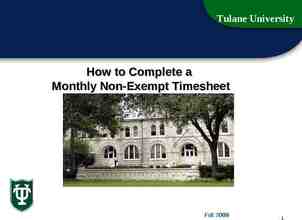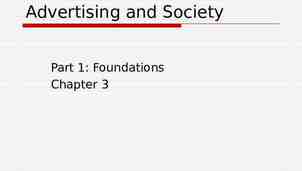Scientific Workforce Diversity in Extramural Research
40 Slides8.40 MB
Scientific Workforce Diversity in Extramural Research Transition Training Navigation Mentorship Support Funding
Your Guides Charlene E. Le Fauve, Ph.D. Marguerite Matthews, Ph.D. Senior Advisor to the Chief Officer for Scientific Workforce Diversity [email protected] Scientific Program Manager Office of Programs to Enhance Neuroscience Workforce Diversity (OPEN) National Institute of Neurological Disorders and Stroke (NINDS) [email protected] Lauren Hill, Ph.D. Kenneth Gibbs, Ph.D., M.P.H. Acting Director Office for Disparities Research and Workforce Diversity National Institute of Mental Health (NIMH) [email protected] Chief, Undergraduate and Predoctoral CrossDisciplinary Training Branch National Institute of General Medical Sciences (NIGMS) [email protected] Ericka M. Boone, Ph.D. Acting Director, Division of Biomedical Research Workforce Office of Extramural Research (OER) [email protected]
Scientific Workforce Diversity Guidance Why Diversity Matters to NIH – Dr. Le Fauve NIH 101: A Primer for ESI and 1st Time Applicants – Dr. Lauren Hill Strategies to Support Your Research Training – Dr. Marguerite Matthews Career Stage Transitions – Dr. Kenneth Gibbs
Scientific Workforce Diversity Guidance Why Diversity Matters to NIH – Dr. Le Fauve NIH 101: A Primer for ESI and 1st Time Applicants – Dr. Lauren Hill Strategies to Support Your Research Training – Dr. Marguerite Matthews Career Stage Transitions – Dr. Kenneth Gibbs
Why Diversity Matters: Capitalizing on the Opportunity Excellence, Creativity, Innovation Broadening Scope of Inquiry: Health Disparities Changing Demographics: Types of Diversity Global Research Preeminence diversity.nih.gov www.diversity.nih.gov 5
Chief Officer for Scientific Workforce Diversity (COSWD) MISSION To be the NIH thought leader in the science of scientific workforce diversity, using data-driven approaches to take advantage of the full range of scientific talent, fostering creativity and innovation in science. MAIN GOAL To catalyze the development of cultures of inclusive excellence, allowing NIH and NIH-funded institutions to benefit from a full range of talent. Build the evidence using the NIH as a testbed for innovative scientific programs. Great Minds Think Differently Disseminate the evidence through work with the full scientific community, from trainees to established tenured scientists. Act on the evidence by piloting integrated, institution-wide systems to address bias, faculty equity, mentoring, and work/life issues. diversity.nih.gov diversity.nih.gov
10000% Underrepresented African American or Black Hispanic or Latina/o/x American Indian Alaska Native Native Hawaiian Pacific Islander 9000% 8000% 7000% 6000% 5000% Well-Represented White Asian 4000% 3000% 2000% 9 8 7 Series1 6 Series2 5 Series3 4 Series4 3 0% 2 1000% 1 Percent Representati on in Biological/Biom edical Sciences and M edicine, 2 0 1 7 - 2 0 1 8 Diminishing Representation for Women and URG Scientists https://nces.ed.gov/programs/digest/2019menu tables.asp; https://www.aamc.org/data-reports/facultyinstitutions/interactive-data/data-reports/faculty-institutions/interactive-data/2018-us-medical-schoolfaculty diversity.nih.gov www.diversity.nih.gov 7
NIH Approaches to Inclusive Excellence Distinguished Scholars Program –Build a self-reinforcing community of PIs committed to diversity and inclusion Faculty Institutional Recruitment for Sustainable Transformation (FIRST) Trans-NIH searches for tenure track positions NIH Equity Committee –Transparency and accountability National Research Mentoring Network (NRMN) Implicit-bias mitigation –NIH SWD Interactive Toolkit Recruitment search protocol Tips for reducing implicit bias Contact NIH SWD for more information: [email protected] diversity.nih.gov www.diversity.nih.gov 8
NIH Approaches to Inclusive Excellence diversity.nih.gov www.diversity.nih.gov 9
NIH 101: A Brief Primer (Who’s On 1st ?) Why Diversity Matters to NIH – Dr. Le Fauve NIH 101: A Primer for ESI and 1st Time Applicants – Dr. Lauren Hill Strategies to Support Your Research Training – Dr. Marguerite Matthews Career Stage Transitions – Dr. Kenneth Gibbs
Presentation Overview NIH Institutes and Centers (ICs) Finding the right “scientific home” for your research Working with NIH Program Officers (POs) 11
NIH is composed of 27 Institutes and Centers (ICs) Office of the Director National Institute on Aging National Institute on Alcohol Abuse and Alcoholism National Institute of Allergy and Infectious Diseases National Institute of Arthritis and Musculoskeletal and Skin Diseases National Institute on Deafness and Other Communication Disorders National Institute of Dental and Craniofacial Research National Institute of Diabetes and Digestive and Kidney Diseases National Institute on Drug Abuse National Institute of General Medical Sciences National Heart, Lung, and Blood Institute National Human Genome Research Institute National Institute of Mental Health National Institute of Neurological Disorders and Stroke National Institute of Nursing Research Fogarty International Center National Center for Advancing Translational Sciences National Library of Medicine National Institute of Biomedical Imaging and Bioengineering National Institute on Minority Health and Health Disparities National Center for Complementary and Integrative Health 12 Clinical Center Center for Information Technology National Cancer Institute National Institute of Environmental Health Sciences National Institute of Child Health and Human Development National Eye Institute No funding authority Center for Scientific Review
The National Institutes of Health Each IC has its own mission Each IC has its own budget Each IC has its own activities Each IC has its own way of doing business Contact a Program Officer at the IC before you submit a grant application 13
Typical NIH IC Organizational Structure National Advisory Council Office of the Director Intramural Research Extramural Research Scientific Programs & Divisions Program Review Board of Scientific Advisors Laboratory Studies Grants Management Clinical Studies
Interacting with NIH: Extramural Investigators/Trainees NIH People Program Officer Scientific Review Officer Scientist & Administrator Scientist & Administrator Identifies areas of scientific need Manages grant reviews Communicates NIH priorities to investigators and others Manages grants 15 Communicates with IC Leadership about the science Appoints members to review groups & panels Prepares summary statements Grants Management Officer Implements the funding process Oversees the budget Ensures grantee compliance with NIH policies & regulations
Identifying the Appropriate IC and Program Officer Talk to mentors and colleagues Search NIH RePORTER for funded projects Search NIH MATCHMAKER for similar projects and their POs Review IC missions, strategic plans, & research priorities Review IC division or program webpages 16
Contacting a Program Officer – General Guidelines Contact POs via email Include a 1-2 Page Concept Paper Research Project Grants (RPG) – include brief background, significance of the problem or question the project will address and specific aims Training (e.g., F30, R36, F31, F32) and Career Development Grants (e.g, K01, K08, K23) – brief background, significance of the problem or question the project will address, specific aims; training goals; mentoring team and their current funding and a CV or NIH Biosketch Follow-up as needed – email piles are deep 17
Getting Engaged: Strategies to Support Your Research Training Why Diversity Matters to NIH – Dr. Le Fauve NIH 101: A Primer for ESI and 1st Time Applicants – Dr. Lauren Hill Strategies to Support Your Research Training – Dr. Marguerite Matthews Career Stage Transitions – Dr. Kenneth Gibbs
Utilize a Systemic Approach
https://researchtraining.nih.gov
Research Supplements to Promote Diversity Supplement funding to active NIH research grants (e.g., R, P, U) to support research training of high school students through junior faculty. o Research Transition Awards (R00) should check with their Program Officer before applying for a supplement. All NIH ICs participate in the Diversity Supplement Program, but each IC has different deadlines and policies Administratively reviewed (no peer review) by the IC funding the original grant – projects must be within scope of the parent grant Supplements provide salary and fringe benefits; funds for supplies and trave; tuition for predocs Typically, 1-3 years of “bridge funds” to allow the supplement awardee to gain the research experience, preliminary data, and/or other skills to prepare a strong application for independent NIH funding. o Feeder program for training awards such as Fs and Ks PA-21-071: IC Specific Contacts and Information 21
Pursuing Your Own Funding Fellowships - F F32 - Ruth L. Kirschstein Postdoctoral Individual National Research Service Award o o o o Parent F32 – supported by 20 ICs NINDS F32 – candidates can apply 12mo prior to but no more than 12mo after starting a postdoc position BRAIN F32 – candidates can apply 12mo prior to but no more than 12mo after starting a postdoc position NIA F32 – promoting diversity in AD/ADRD research Career Development Awards - K K01 - Mentored Research Scientist Career Development Award o 25 active FOAs for postdocs and/or junior faculty K99/R00 - Pathway to Independence Award o o o o 22 Parent K99/R00 – supported by most ICs MOSAIC K99/R00 – promoting diversity, supported by most ICs BRAIN K99/R00 – promoting diversity NINDS K99/R00 – promoting diversity in AD/ADRD research
NIH-Supported Training at Institutions Ruth L. Kirschstein Institutional National Research Service Award (T32) NIH supports 1800 projects that enable over 200 institutions nationwide to recruit and support predoctoral and postdoctoral scientists and provide structured training in a various biomedical disciplines Institutional Career Development Program Award (K12) Prepare postdoctoral and clinician scientists for independent research careers
NIH-Supported Career Development and Networking Opportunities Research Education Program (R25) The purpose of this type of program is to support research education activities that complement and/or enhance training, enhance diversity , help recruit individuals with specific disciplinary backgrounds to research careers, and/or foster a better understanding of given research topics. » NIH Neuroscience Development for Advancing the Careers of a Diverse Research Workforce – for predoc through junior faculty researchers » Enhancing NIDCD's Extramural Workforce Diversity through Research Experiences (new) – for undergrad through mid-career faculty researchers » Mentoring Networks to Enhance Diversity in NIDCD's Extramural Research Workforce (new) – for undergrad through predoc researchers
Finding an R25 Well-Suited for Your Needs https://reporter.nih.gov/advanced-search
Finding an R25 Well-Suited for Your Needs
Using Social Networks for Support and Guidance
Using Social Networks for Support and Guidance https://www.jasminekwasa.com/blog/fellowship-cheatcodes
Career Stage Transitions Why Diversity Matters to NIH – Dr. Le Fauve NIH 101: A Primer for ESI and 1st Time Applicants – Dr. Lauren Hill Strategies to Support Your Research Training – Dr. Marguerite Matthews Career Stage Transitions – Dr. Kenneth Gibbs
MOSAIC Program to Promote Faculty Diversity MOSAIC is designed to facilitate the transition of promising postdoctoral researchers from diverse backgrounds, for example individuals from groups underrepresented in the biomedical research workforce at the faculty level, into independent, research-intensive faculty careers The overarching goal of the NIH MOSAIC program is to enhance the diversity of independent investigators conducting research within the NIH mission. Program priority is to address documented underrepresentation at the faculty level (e.g., see NIH’s Notice of Interest in Diversity). https://www.nigms.nih.gov/training/careerdev/Pages/MOSAIC.aspx
Maximizing Opportunities for Scientific and Academic Independent Careers (MOSAIC) Postdoctoral Career Transition Award to Promote Diversity (K99/R00) – PAR-21-271, -272, and -273 Institutionally Focused Research Education Cooperative Agreement to Promote Diversity (UE5) – PAR-21-277 MOSAIC K99/R00 Applicants https://www.nigms.nih.gov/training/careerdev/Pages/MOSAIC.aspx 31
Maximizing Opportunities for Scientific and Academic Independent Careers (MOSAIC) Postdoctoral Career Transition Award to Promote Diversity (K99/R00) – PAR-21-271, -272, and -273 Institutionally Focused Research Education Cooperative Agreement to Promote Diversity (UE5) – PAR-21-277 MOSAIC K99/R00 Applicants MOSAIC K99/R00 Scholars Participate in Cohorts Organized by UE5 https://www.nigms.nih.gov/training/careerdev/Pages/MOSAIC.aspx 32
Maximizing Opportunities for Scientific and Academic Independent Careers (MOSAIC) Postdoctoral Career Transition Award to Promote Diversity (K99/R00) – PAR-21-271, -272, and -273 Institutionally Focused Research Education Cooperative Agreement to Promote Diversity (UE5) – PAR-21-277 MOSAIC K99/R00 Applicants MOSAIC K99/R00 Scholars Participate in Cohorts Organized by UE5 https://www.nigms.nih.gov/training/careerdev/Pages/MOSAIC.aspx Nearly all NIH ICs participate in the MOSAIC K99/R00 program Special emphasis on contributions and commitment to promote diversity K99/R00 applications accepted 3x per year (February, June, October) To date, 75% of applicants from URM groups 33
2021 NIH MOSAIC Scholars https://www.nigms.nih.gov/training/careerdev/Pages/mosaic -scholars.aspx 34
Early-Stage Investigator (ESI) An NIH ESI is a New Investigator who has completed their terminal degree or medical residency (or the equivalent and whichever date is later) within the past ten years and has not yet been awarded a substantial, competing NIH research grant. Status can be extended for childbirth (1 year per childbirth in ESI window) and other reasons (e.g., COVID-19 related disruptions, family care responsibilities, active-duty military service) considered on a case-by-case basis. Receive special attention at Review (career stage), National Advisory Council (high program priority) and potentially increased payline for scored R01 applications from Early-Stage Investigators https://grants.nih.gov/policy/early-stage/index.htm
NIGMS MIRA (R35) Applications focus on the investigator and the overall program of research in the lab within the mission of NIGMS Significance of past and recent contributions to science and to the scientific community Impact of proposed work while deemphasizing details of approach Two FOAs: PAR-19-367: For Established Investigators PAR-20-117: For Early-Stage Investigators (preliminary data not required!) https://www.nigms.nih.gov/research/mechanisms/mira/pages/default.aspx
Stephen I. Katz Early Stage Investigator Research Project Grant (R01) New Research Directions (e.g., new approach, methodology, technique, discipline, target, paradigm) – specific attachment Can rely on the applicant’s prior work and expertise as its foundation, but should not be an obvious or incremental advancement, expansion or extension of a previous research effort Unpublished data not allowed It is important to check which NIH ICs are signed onto each FOA PAR-21-038: Clinical Trial Not Allowed PAR-20-039: Clinical Trial Required https://grants.nih.gov/funding/katz-esi-r01.htm
NIH Loan Repayment Program 2-year Research Commitment Up to 50,000/year New: ASSIST and REACH LRP Resources Extramural LRP Application Deadline November 18, 2021
Extramural LRP Subcategories For individuals conducting research at non-profit institutions
Thank You Very Much For Attending! Please check the Virtual Seminar agenda for additional sessions that may be of interest!













































